Western Digital Expands HGST Helium Drive Lineup with 10TB Ultrastar He10
by Ganesh T S on December 2, 2015 3:01 AM EST- Posted in
- Enterprise
- Storage
- HDDs
- Western Digital
- HGST
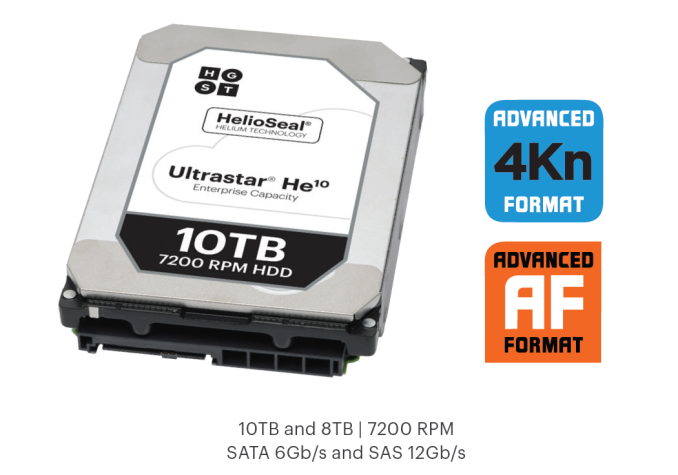
HGST, a Western Digital subsidiary, has been shipping hard drives sealed with helium for a couple of years now. Their helium drives have so far come in two flavors - the Ultrastar He drives using platters with traditional perpendicular magnetic recording (PMR) technology and the Ultrastar Archive Ha drives using platters with shingled magnetic recording (SMR). There are two main patented innovations behind the helium drives, HelioSeal and 7Stac. The former refers to placement of the platters in a hermetically sealed enclosure filled with helium instead of air. The latter refers to packaging of seven platters in the same 1" high form factor of traditional 3.5" drives.
The Ultrastar He6 6TB drive was introduced in November 2013, and this was followed by the He8 8TB drive late last year. In June 2015, the Ultrastar Ha10 SMR drive with HelioSeal technology was introduced. Around the same time, HGST also made it known that more than 1M HelioSeal units had been deployed. 1.33 TB platters have become available in air drives now, and HGST is taking advantage of that in the 10TB Ultrastar He10. The launch of the Ultrastar He10 PMR drive today also brings the news that more than 4M HelioSeal units have been deployed in various datacenters - pointing to the rapid rise in adoption rate of this technology.
We have already seen in our reviews that the helium drives offer the best performance to power ratio and watts per TB metric amongst all the drives in their capacity class. HGST also claim a 2.5M hour MTBF - much higher than traditional enterprise PMR drives. The initial cost of the helium drives have been substantially higher compared to the standard drives of the same capacity, but the TCO (total cost of ownership) metric is highly in favor of these drives - particularly for datacenter customers who need the drives to be active 24x7. HGST's press briefing included a slide that presented the potential TCO benefits that come about due to the increased capacity per rack, lower consumption per rack and lower power consumption per TB of the new He10 drives.
HGST indicated that the ramp in volume should help the initial cost to approach that of the air drives in the near future. For datacenter customers, that would mean an acceleration in obtaining the TCO benefits.
Coming to the core specifications, the Ultrastar He10 will come in both SATA 6Gbps and SAS 12Gbps varieties. The drives have 4KB sectors, though SKUs with 512-byte emulation are also available. Various data security options such as instant secure erase, self-encryption, secure erase and TCG encryption with FIPS are available.
The standard Ultrastar He drive features such as rotational vibration safeguard (for better RV tolerance in multi-drive servers) and the rebuild assist mode (for faster RAID rebuild) are retained. The drives come with a 256MB DRAM buffer.
Hard drives are struggling to reach the 10TB capacity point with traditional PMR technology. While Seagate did announce a few 8TB PMR drives earlier this quarter, it really looks like vendors need to move to some other technology (shingled magnetic recording or heat-assisted magnetic recording (HAMR)) in order to keep the $/TB metric competitive against the upcoming high-capacity SSDs. As of now, helium seems to be the only proven solution causing minimal performance impact and HGST appears to have a strong hold in this particular market segment.


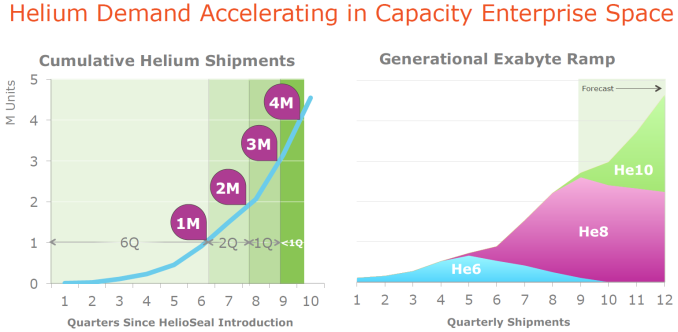
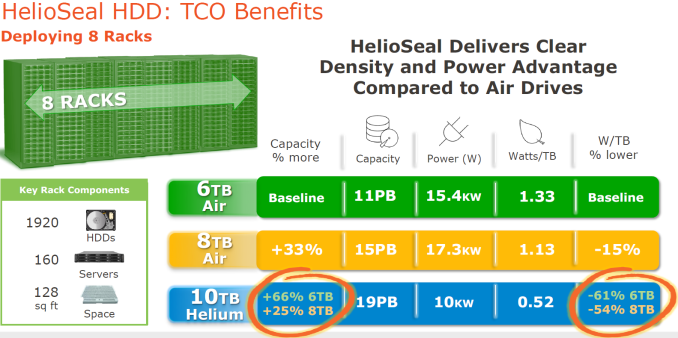
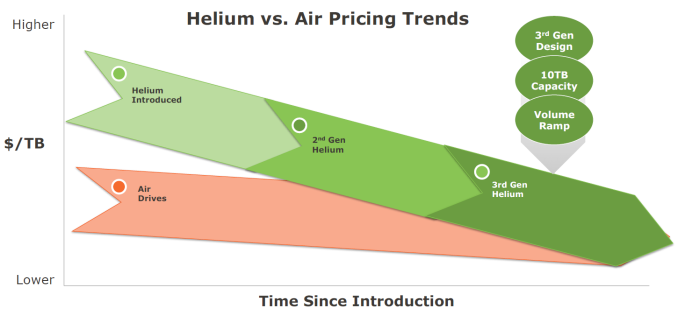
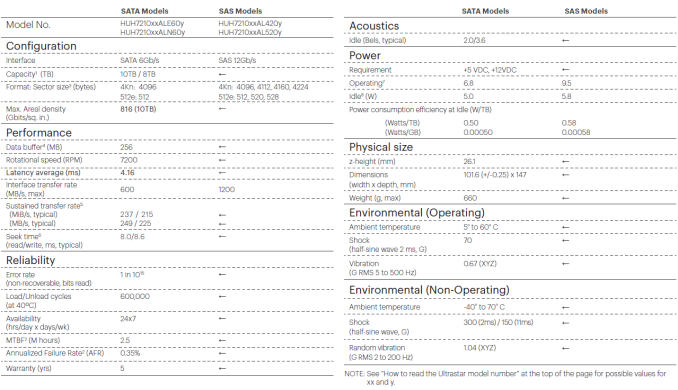
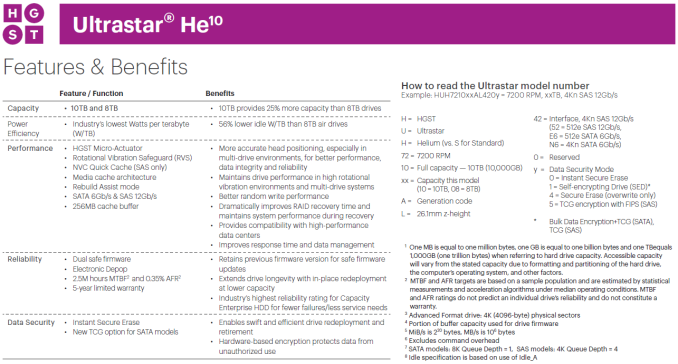








113 Comments
View All Comments
Samus - Friday, December 4, 2015 - link
No offense, but if 5.25" drives were a good idea, one of the multi-billion dollar drive manufactures would have jumped on it. They obviously know some things you don't.The last company to try mainstream 5.25" drives was Quantum, and look where they are...
And the real giveaway that going largest is a bad idea is that going smaller is/has been the trend for quite some time. Outside of data centers, most modern servers ship with 2.5" bays/backplane for SSD's and 2.5" SAS drives. And in data centers, no racks are designed for 5.25" formats and when you consider the huge power consumption increase those drives will have over even 3.5" drives (which use twice as much power as their 2.5" equals) while the entire industry is trying to be greener, even IF the drives doubled capacity while keeping performance the same (doubtful but not impossible) the fact that the drives occupy nearly twice as much physical space at a higher power envelope negates any benefits outside of any potential initial cost savings.
5.25" form factor is long dead and it isn't coming back. The world is going leaner, not bulkier.
qlum - Wednesday, December 2, 2015 - link
More importantly the whole infrastructure is build around the current format so if you where to increase the size you would make it impossible to upgrade existing drives without replacing the racks for the new infrastructure, and besides that bigger drives also take up more space giving you room for much less space per rack.On the manufacturers side they would have to first figure out how to best make the drives 5.25 and that takes up quite a bit of r&d and sure there would be more capacity per drive but it probably won't warrant the cost to start making them or the barrier to start implementing them.
wiz329 - Wednesday, December 2, 2015 - link
+1. Hard drives are not a growth market. Therefore, you won't see large amounts of capital investment flowing into these divisions. It'll be about containing costs and managing the decline.Sivar - Wednesday, December 2, 2015 - link
I was with StorageReview.com as moderator, user, and often technical editor for years and am now an engineer 50 ft. from a class 10 cleanroom, and I'll tell you guys: Listen to shodanshok. He knows what he is talking about.ddriver - Wednesday, December 2, 2015 - link
I'll pass ;) love your legit credentials thou LOL, also, he might know what he is talking about, but he obviously has no idea what I am talking about, so his responses are intrinsically misplaced and do not apply.As usual, the bulk of AT visitors aren't particularly big on "outside the box".
weissPC - Thursday, December 3, 2015 - link
@ddriver - SSD was the "outside the box" solution. If you want speed, go for SSD, if you want capacity go for HDD. Doubling the number of read heads on a disk surface still won't get you near the seek nor read speeds of a SSD. That's why even the WD Raptors are quite irrelevant now. Let each focus on their niche.Your "outside the box" ideas doesn't make engineering sense.
jasonelmore - Wednesday, December 2, 2015 - link
"5.25" platter would be much vibration-prone, with resulting lower RPM (< 4000, probably)"yeah thats why 90% 2.5 laptop drives are lower RPM /sarcasm
There is more room to fit complex dampening technologies in that form factor.
The real reason you should have dismissed this idea is enterprise would never use it due to space.
The Enterprise Market pays the bills , and consumers get the leftovers
SunLord - Wednesday, December 2, 2015 - link
Hmm I wonder how many platters you could stack in a drive as tall as a 5.25" baymilli - Wednesday, December 2, 2015 - link
Look up Quantum Bigfoot. I'm sure history won't repeat itself.djgandy - Wednesday, December 2, 2015 - link
+1. I had one of these drives. It was so slow and the seek noise was awful.